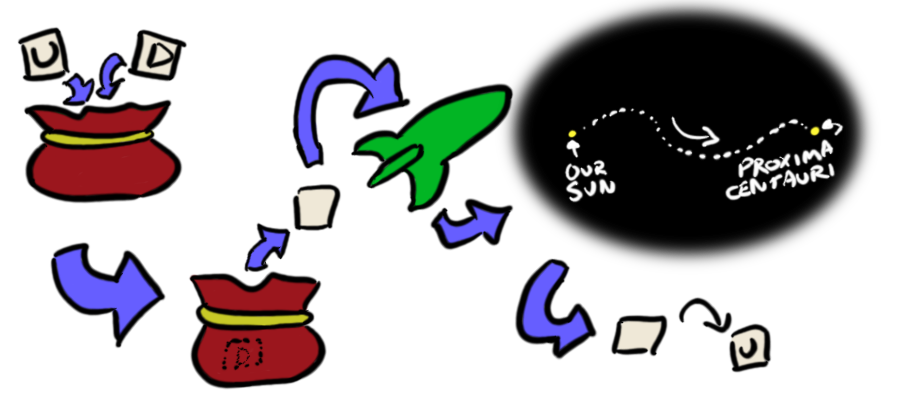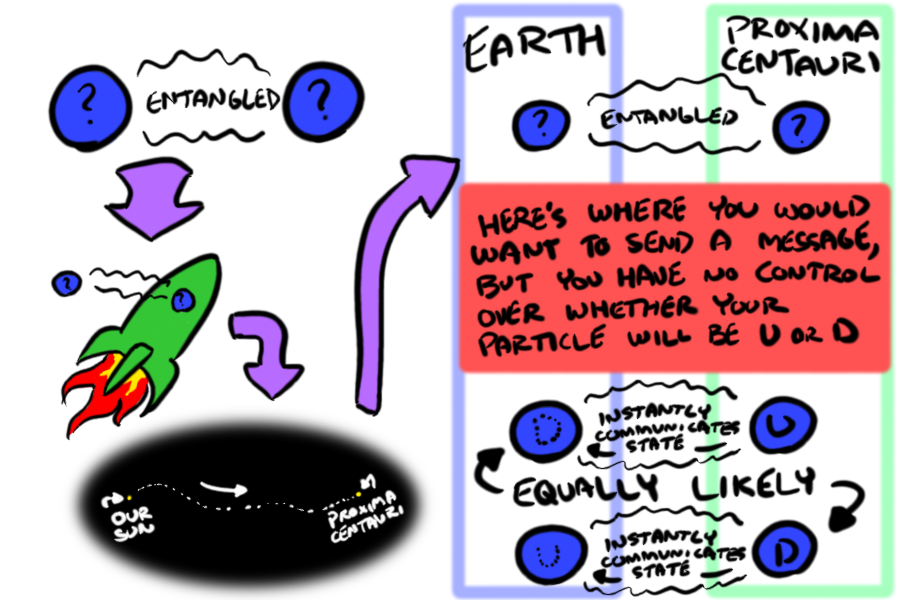 Quantum Entanglement
Quantum Entanglement
Oh what a tangled state we weave,
When first we practise to perceive!
(With apologies to Sir Walter Scott)
Quantum Entanglement. Spooky action at a distance. Quantum teleportation. Instantaneous transfer of information. Oh, man, does the science media love to talk about this. As does everyone who read a few articles and starts thinking of the wild possibilities. But quantum mechanics is a very, very tricky subject, which may be why I've held off on talking about it until now. No doubt someone will find something wrong with what I say, because I don't have any sort of advanced degree in the subject, and hoo boy is it complicated. Today, though. we're just going to talk about entanglement, one of the fun aspects of quantum mechanics that doesn't really mean what most people think, in its simplest form (because it gets complex fast). And I'm going to rain all over the sci-fi parade. I'm sorry in advance.
To really understand quantum entanglement, I'm actually going to give you a rather unremarkable explanation of a classical phenomenon. Then, we're going to examine why it's absolutely bonkers. The side effect of this is that you'll hopefully understand that "spooky action at a distance," as Einstein called it, can't transmit any useful information, and no faster-than-like ansible is possible through entangled states.
Let's say that you have two scrabble tiles. One has the letter "U," and one has the letter "D." You put them both in a bag, and you shake them up. Now, you pull out one of them. You can say, with absolute certainty, what the one still in the bag must be. It's just a matter of deduction. If you pulled out the "U," the other one is the "D," and vis versa. Let's say you repeat the experiment, but now, after you draw a tile, but before you look at it, you hop into a rocket ship. You fly that rocket to the nearest star, which is about four light-years away. Now, you look at the tile. Instantly, you know what the other tile must be. Again, it's obvious deduction. In this case, there was no faster-than-light transmission of information, the tiles were always set up that way, only now you know their full configuration because the "state" of the tile you had is tied to the "state" of the other one. Simple.

I tried to get funding for this experiment from the NSF, but they turned me down.
Some of you may have gotten ahead of me with the scrabble tiles, and noted that "U" and "D" probably stand for "Up" and "Down." In quantum mechanics, sub-atomic particles, such as an electron, have a quantity called "spin." This may or may not be an actual spin, because a particle can have a "spin" in three directions (the spin has units of angular momentum, but quantum mechanics is weird). However, let's take a look at two particles, one with an Up spin in the Z-axis, and one with a Down spin in the Z-axis. We could now reproduce our scrabble experiment with these particles in place of the tiles. Still this makes, classical, intuitive sense. So, of course, our intuition is totally, completely, wrong.
See, what we've been dealing with so far is our understanding of combined states in a classical sense. In this case, each of our particles (or scrabble tiles) has a state, its spin. Together, the system has a state, which is their combined state. Classically, and intuitively, we know that the combined state can be broken down into two individual states which are independent of each other. And that is the case here. Particle 1, in its "Up" state, is completely independent of particle 2, in its "Down" state. But what if that wasn't the case?
Let's say now that you have two scrabble tiles, but they're super high-tech tiles. Both of them are blank, and, until you hit a button on the back of them, they won't have a "U" or "D" written on them. The letter that will appear on either tile will always be a "U" or a "D," but you don't know which one it will be until the button is pressed. However, when you press the button on one and reveal the letter, the other tile will always display the other letter when its button is pressed. If you repeat the second part of the scrabble experiment, and fly four light-years away from the bag before pressing the tile, if it displayed a "U," you would know instantaneously that the other tile will display a "D." And if someone else pressed the button on the other one, four light years away, a second after you pressed yours, their tile would display a "D." The outcome is the same as our low-tech variant of the experiment, but it leaves us with a conundrum.

High-tech scrabble tiles are neon blue, obviously.
There are two ways for our high-tech scrabble pieces to work. The first way would be that, from the beginning, the "U" and "D" are already set, and are merely revealed when the button is pressed. Thus, the set up is identical to our low-tech variant, only the actual letters were simply "hidden." The other way would be that, when you press the button on your scrabble piece, it "decides" to be either "U" or "D," and then sends that information to the other scrabble tile instantaneously, so that the other person holding it will see the opposite letter a second later when they hit their button.
Again, our scrabble set-up is an analogue for a real-life quantum mechanics set-up (except the flying to Proxima Centauri part). In this case, our tiles are still sub-atomic particles, and the letters are still the spin state of the particle. However, now our particles are "entangled," the state of one depends on the other. The group state cannot be decomposed into two independent states for particle 1 and particle 2. Our button on the back of each tile, in this case, is analogous to measuring the spin state of the particle. So, we entangle two particles, separate them by an incredibly long distance, then measure each of them. So far, this doesn't sound crazy, because I haven't finished revealing all the analogues in our scrabble experiment.
The first way of implementing our high-tech scrabble tiles is also something in quantum mechanics, called the "Hidden Variables Theory." It simply states that there are some hidden variables which are part of the state of each particle when they are first entangled, and when we measure the state later we're just measuring those variables. More simply, the spin was set the whole time, we only just found out about it when we measured it. Therefore, there's nothing weird going on, and no "normal" laws of physics are violated. The other way the tiles could be implemented would be called "spooky action at a distance," where the spin state is "decided" when we measure it, and that communicates the state instantly to the other entangled particle, which would be bonkers, and seems to break the nothing-can-travel-faster-than-the-speed-of-light rule.
Guess which way quantum entanglement works. That's right, the "bonkers" way.
I can't really give a satisfactory answer here to why the first interpretation, the "Hidden Variables Theory," is false, aside from saying that Bell's Theorem has shown that there can be no hidden state variables. It's rather complicated, and I don't want to complicate this already complex post with even more craziness. I may do a post on it in the future, or you can always look it up. So, to put the second part in a purely quantum mechanical way, let's summarize:
You have two entangled particles, which have a group state, composed of each of their individual states, which we'll call their wavefunctions (I'll get into that weirdness some other time). These entangled particles are separated, and then both measured. When you measure the state of one of the particles, you are "collapsing" its wavefunction. This will instantaneously cause the entangled pair's wavefunction to also collapse, "deciding" its state too (before this, due to the weirdness that is quantum mechanics, each particle was actually in both states, called a superposition). There are no hidden variables in this whole mess, which means that the state information is somehow communicated faster than the speed of light to the other entangled particles. This is what Einstein famously referred to as "spooky action at a distance." Collapsing a particle's wavefunction (into one state) can cause another particle, even billions of light-years away, to have its wavefunction also collapse (into the opposite state), instantly. And it's absolutely nuts.
However, I said I was going to rain all over the sci-fi faster-than-light communication parade. And here's why: did you note that the outcome of our experiment is just like the classical outcome? In our classical one, we didn't know whether or not we had the "U" or "D" until we looked at it. Once we looked, we knew instantly what the other tile was, but there's no way we could use that bit of information to communicate, because we didn't know what it was going to be until we looked. The quantum entanglement effect is similar, except that looking decides the state of the particle, and it instantly causes the other particle to be the other state, no matter how far away. The rub, of course, is that we don't decide the state, we only measure, or observe it. We find out what state it is in, which means that we can't control the message sent faster-than-light. Well, we don't really "find out," so much as "cause it to pick a state by measuring it," which then causes it to make the other particle then pick the other state, but you get my drift. Maybe? This wording is somewhat confusing, so I drew a picture.

Particles not actual size.
Since, at the point we'd like to send our faster-than-light message (where we're now four light-years away from the other particle/scrabble tile), we have no control over what state the particle will be in (Up or Down), we can't send any kind of useful information faster-than-light using the entangled nature of the two particles. This is the sad but unfortunate truth of quantum entanglement. It's super awesome and downright absurd in how it works, but it can't be harnessed to communicate faster-than-light.
It's not as cool as the instantaneous communication promised to us via quantum entanglement by plenty of sci-fi universes, but it's still pretty neat. It's just neat in the "not practically usable" sense, and super weird in the everything else sense. Because we totally thought nothing can travel faster than the speed of light, but this does. And that is really cool and also really strange. It's just important to know what that really implies, and FTL communication or teleportation isn't it. Sorry.
